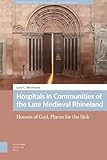Hospitals in Communities of the Late Medieval Rhineland / Lucy Barnhouse.
Material type: TextSeries: Premodern Health, Disease, and Disability ; 9Publisher: Amsterdam : Amsterdam University Press, [2023]Copyright date: ©2023Description: 1 online resource (250 p.)Content type:
TextSeries: Premodern Health, Disease, and Disability ; 9Publisher: Amsterdam : Amsterdam University Press, [2023]Copyright date: ©2023Description: 1 online resource (250 p.)Content type: - 9789048552238
- 362.110943430902
- online - DeGruyter
| Item type | Current library | Call number | URL | Status | Notes | Barcode | |
|---|---|---|---|---|---|---|---|
 eBook
eBook
|
Biblioteca "Angelicum" Pont. Univ. S.Tommaso d'Aquino Nuvola online | online - DeGruyter (Browse shelf(Opens below)) | Online access | Not for loan (Accesso limitato) | Accesso per gli utenti autorizzati / Access for authorized users | (dgr)9789048552238 |
Frontmatter -- Table of Contents -- Acknowledgements -- Introduction -- 1 Houses of God -- 2 Civic Hospitals in the City and Archdiocese of Mainz -- 3 Mainz’s Hospital Sisters and the Rights of Religious Women -- 4 Leprosaria and the Leprous: Legal Status and Social Ties -- 5 “For all miserable persons”: Small and Extra-Urban Hospitals -- 6 Hospitals and their Networks: Recreating Relationships -- Conclusion -- Bibliography -- Index
restricted access online access with authorization star
http://purl.org/coar/access_right/c_16ec
From the mid-twelfth century onwards, the development of European hospitals was shaped by their claim to the legal status of religious institutions, with its attendant privileges and responsibilities. The questions of whom hospitals should serve and why they should do so have recurred — and been invested with moral weight — in successive centuries, though similarities between medieval and modern debates on the subject have often been overlooked. Hospitals’ legal status as religious institutions could be tendentious and therefore had to be vigorously defended in order to protect hospitals’ resources. This status could also, however, be invoked to impose limits on who could serve in and be served by hospitals. As recent scholarship demonstrates, disputes over whom hospitals should serve, and how, find parallels in other periods of history and current debates.
Mode of access: Internet via World Wide Web.
In English.
Description based on online resource; title from PDF title page (publisher's Web site, viewed 06. Mrz 2024)


